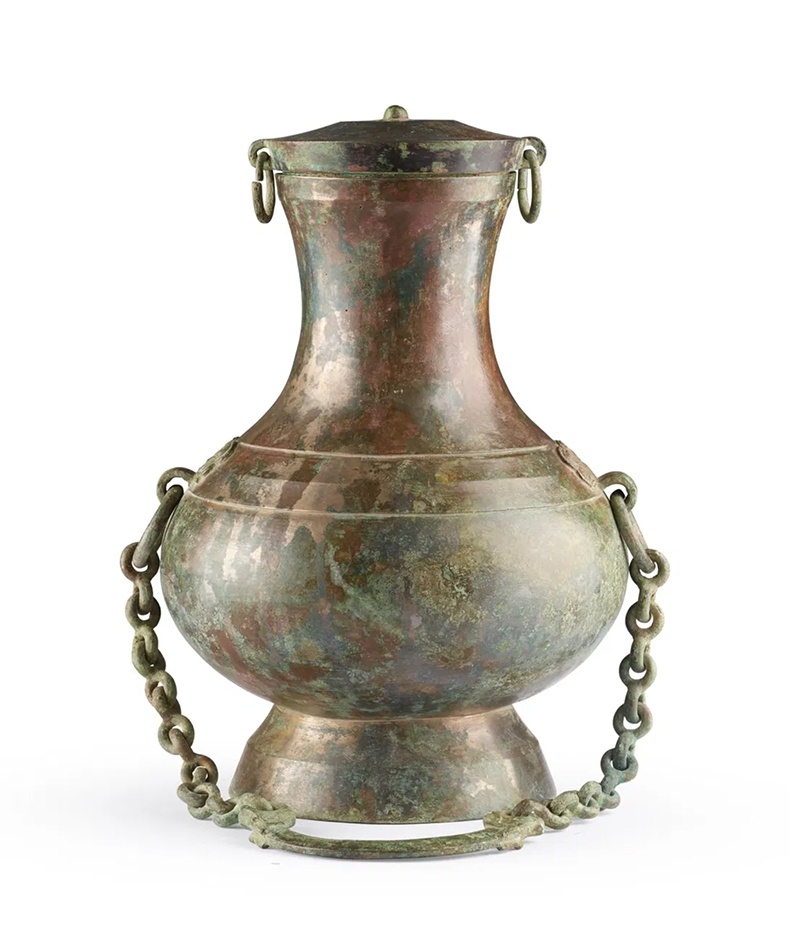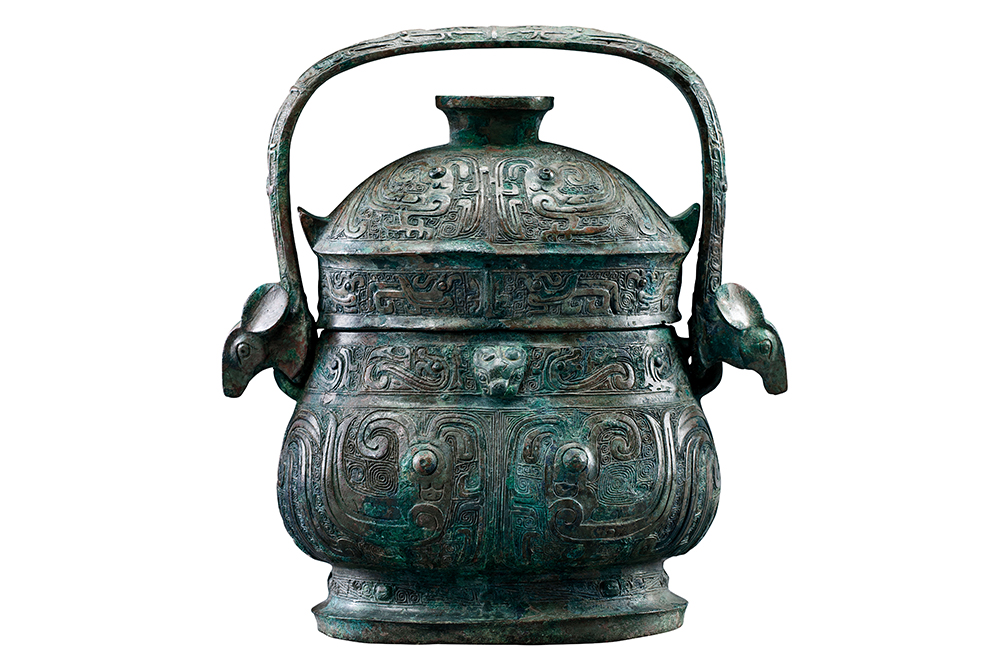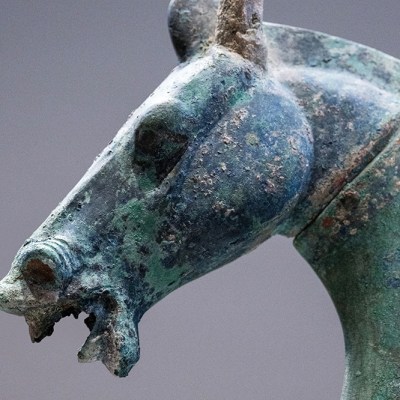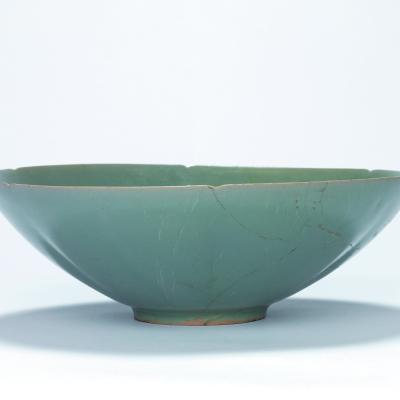From the February 2025 issue of Apollo. Preview and subscribe here.
Archaeology dates the invention of bronze casting in China to the Shang dynasty (1600–1046 BC), more than 3,000 years ago. Myth pushes the technology further back: in one origin story, Yu the Great, founder of the Xia dynasty in c. 2070 BC, having rescued the land from floods, divided his territory into nine provinces, demanding tribute in bronze from each. This metal he cast into nine large tripod cauldrons, symbols of the heavenly mandate to rule. The cauldrons had disappeared by the end of the Zhou dynasty, in 256 BC, but the reverence for bronze objects and vessels persisted.
The earliest extant bronze objects are bells, ritual weapons and vessels for wine, cooking and serving which were used for ritual offerings of food and drink to ancestors and other deities. Many were made to adorn the tombs of the ruling elite so that they could participate in ritual banquets after death. The excavation in 1976 of the tomb of Fu Hao, priestess, warrior and one of the many wives of King Wu Ding (ruled c. 1250–1192 BC), unearthed 468 bronze objects, including 130 weapons and 23 bells. The bold vessel forms and vigorous three-dimensional designs, especially the characteristic animal mask or taotie decorations found on almost every Shang dynasty vessel, were achieved through the laborious piece-mould process, in which the original model was destroyed. Every piece is thus unique. Scholars debate when Chinese bronze casters adopted the lost-wax method of casting, but it was certainly before the unification of China under the Qin dynasty (c. 221–206 BC). From the Song Dynasty (960–1279 AD) onwards, these early bronze ritual vessels were so highly valued that Chinese literati commissioned copies in order to honour ancestral spirits appropriately. These copies are of interest to scholars – a show focused on this revivalist tradition, ‘Recasting the Past: The Art of Chinese Bronzes, 1100–1900’, will open at the Met in February – but constitute a quite different, less valuable collectors’ market.
‘Dragon’ chariot terminal, Han dynasty (206 BC–220 AD), China. Bonhams Hong Kong. Photo: courtesy Bonhams

From the Song Dynasty onwards, many archaic Chinese bronzes found their way into Japanese and other Asian collections, and others were retrieved from Chinese excavations and private collections in the late 19th century and the chaotic early part of the 20th. C.T. Loo handled many Chinese bronzes in his Paris and New York galleries during the first half of the 20th century, including outstanding ritual vessels originally from the Qing imperial collection. Significant exhibitions, including the Royal Academy’s International Exhibition of Chinese Art in 1935–36, inspired collectors in Europe and the United States and for many years it was Western collectors who led, drawn to the brooding energy of these archaic pieces and their outstanding craftsmanship. According to Gisèle Croës, a Brussels-based dealer in archaic Chinese bronzes, until the 1970s and ’80s buyers were little interested in provenance and it took many years for scholars to date and fully understand these objects.
Ritual vessels have always been a significant part of imperial and other collections not just as symbols of imperial authority, but also because the inscriptions many of them bear are the earliest surviving written records of ancestral Neolithic cultures. From the Tang dynasty onwards, scholars made rubbings and drawings of these inscriptions as they attempted to decipher them. Later Shang dynasty and early Western Zhou dynasty (11th–10th century BC) inscriptions tend to be single-name dedications. But changing religious practices in the later Western Zhou and the Eastern Zhou periods encouraged more elaborate accounts of significant public events, military campaigns, peace treaties and so on. Croës notes that these inscriptions, so long as they can be confirmed as contemporaneous, significantly add to a vessel’s value, especially for Chinese buyers. It is through the inscription that the unique function and therefore the value of a particular vessel becomes clear: ‘These early bronzes are so complex; you need heart, you need imagination, to understand them. The more you look, the more your curiosity is activated.’ She has available a lidded wine vessel, or you, of the Western Zhou dynasty, with a beautiful brown and green patina, bearing the inscription: ‘Precious sacrificial vessel made by Zhong’. For Chinese buyers today, the connection these objects afford to China’s ancient history is a vital aspect of their value. As Henry Howard-Sneyd, Sotheby’s Chairman of Asian Art, Europe and Americas, puts it, ‘You are buying a lot more than a beautiful object.’
Hu wine vessel, Han dynasty (c. 200 BC), China. Michael Goedhuis, London.

Though their value is partly historical, over the last 20 years as Chinese buyers have become dominant, provenance has become equally significant. Howard-Sneyd cites the sale at Sotheby’s New York last September of the Zhou Zha Hu, a magnificent bronze ritual wine vessel and cover from the Middle Western Zhou dynasty (10th–9th century BC), with an extensive 24-character inscription. Recorded in the first volume of the famous catalogue – commissioned by the Qianlong Emperor in 1749 – of the imperial collections of archaic bronzes, it is half of a unique pair, the other half being in the National Palace Museum in Taipei. Estimated at $3–$5m, it sold for $5.4m. In 2022, a dramatic bronze male chimera (bixie) from the Han dynasty (202 BC–220 AD), achieved HK$35.5m ($4.5m) against an estimate of HK$6m–HK$8m at Sotheby’s Hong Kong. This came from the collection of Sir Joseph Hotung and had previously been owned by the Belgian collector and patron Baron Adolphe Stoclet and the renowned London dealership Eskenazi. Asaph Hyman, Bonhams Global Head of Chinese Ceramics & Works of Art, confirms that ‘collectors greatly value pieces with lengthy documented history’. He cites a very rare you from the Western Zhou dynasty, 10th century BC, which sold from the H Collection at Bonhams London in May 2021. Having been published as early as 1949, ‘It was sold at auction three times before being sold for a fourth time at Bonhams, providing collectors with a firm published history over decades.’ The object’s rarity and a dedicatory inscription helped drive the final price to £200,250, well above the top estimate of £150,000.
Form, modelling and quality of casting also contribute to value, Hyman says, pointing to a large Han dynasty gilt-bronze ‘dragon’ chariot terminal that sold at Bonhams Hong Kong in May 2021 for HK$3.5m ($450,772). As other materials came into use, bronze became increasingly a sculptural medium. For dealer Michael Goedhuis, however, it is the vessels of the Han dynasty and the preceding ‘Warring States’ period that speak most to him. ‘The taste became simple. And the forms developed in bronze from the third century BC onwards became the forms that shaped Chinese culture for 2,000 years.’ He regrets the increasing rarity of good examples on the market, as museums and institutions compete to acquire the best. Besides, there is ‘notable interest among Chinese collectors to retrieve objects taken out of China in the late 19th and early 20th century. Western collectors are up against stiff competition.’ New EU regulations surrounding the trade in archaeological and other material, due to come into force in June this year, are likely to constrain collecting in this field further. But as Howard-Sneyd asks rhetorically, ‘Does that stop people buying?’ For the right pieces, global interest endures.
From the February 2025 issue of Apollo. Preview and subscribe here.



